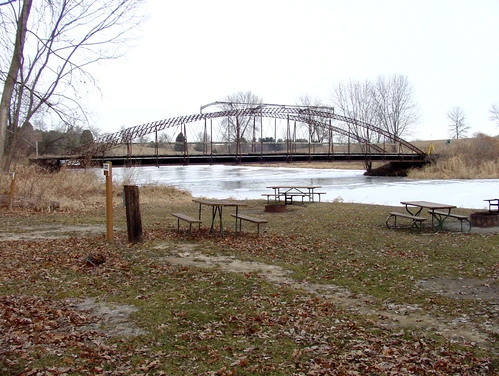- Year constructed: 1873
- Alternate name: Central Park Bridge
- Bridge type: Bowstring Through Arch-Truss
- National Register of Historic Places status: Listed
- Length: Unknown
- Width: Unknown
- Spans: 1
- Jurisdiction: Jones County Conservation Board
- Address: Pedestrian path over small pond in Central Park, 7 miles east of Anamosa, Section 1, T84N-R3W (Jackson Township)
Details
The Fremont Mill bridge now carries a pedestrian path in Central Park in Jackson Township, seven miles east of Anamosa. This wrought iron bowstring through arch-truss originally crossed the Maquoketa River in Monticello. The previous structure at that site was destroyed by a perilous ice flow in the winter of 1873, necessitating the erection of the bowstring. Five companies presented sealed competitive bides to the Jones County Board of Supervisors in the Spring of 1873. County officials followed the customary method of letting out two construction contracts, one for the truss itself and one for the foundations. The contract for the superstructure was awarded to the Massillon Iron Bridge Company of Massillon, Ohio, which bid $23 per lineal foot. The second contract for the substructure was let to James Milne of Scotch Grove, Iowa. The overall contractual deadline for the bridge's completion was initially June 20, 1873, but it was not until October of that year that board minutes reported that the structure was finished. Total cost was $5,428.05, $2,944 of which went to Massillon for the superstructure. In January 1930, the truss was moved to a site spanning Buffalo Creek, and then again to its present location in Jones County's Central Park in July 1936. The well-traveled Fremont Mill Bridge, with few alterations of note, now only carries pedestrians visiting the park.
The bowstring arch-truss was the iron span of choice for Iowa counties in the late 1860s and 1870s. Marketed exclusively throughout the Midwest by such Ohio-based industry giants as the Wrought Iron Bridge Company, the King Iron Bridge Company and the Massillon Bridge Company, these often-patented bridge configurations featured a wide range of span lengths, economical fabrication cost and relatively quick erection. The proliferation of the bowstring corresponded with the initial development of Iowa's road system, and as a result, perhaps thousands of these prototypical iron spans were erected throughout the state. The bowstring had some rather severe structural flaws, however, relating primarily to lateral stability of the arches, and it was largely superseded by the pin-connected truss in the early 1880s. Despite this, some bowstrings were still erected in Iowa in the 1880s, although the number dwindled precipitously by the decade's end. Through subsequent attrition, almost all of Iowa's bowstrings have since been replaced and demolished. Through its association with the Massillon Bridge Company and owing to its excellent state of preservation, the Fremont Mill Bridge is an outstanding early transportation-related resource.
Adapted from Hybben, Roise and Fraser 1992]
Areas Served
- Jones
